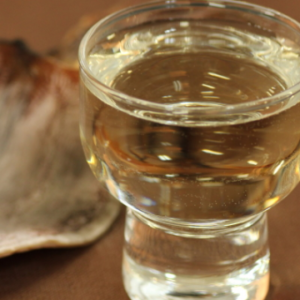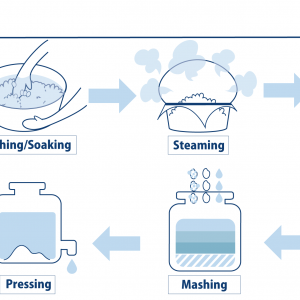
What is shikomi?
Shikomi is an essential step in the sake production process, whereby the brewer combines a yeast starter, steamed rice, koji culture and water in a tank. This mixture ferments to form a bubbling mash called moromi.
The Japanese word shikomi is a noun derived from the verb shikomu. This verb carries multiple meanings relating to the concept of preparation, such as “to procure stock,” “to prepare food” or “to instruct.” In food production, the word shikomu usually refers to mixing ingredients in a tank. From this root meaning, the process of creating sake’s moromi mash became known as “shikomi.”
The standard approach: three-step shikomi
The most common style of shikomi in the sake industry is the three-step method, whereby the brewer adds the ingredients separately in three parts.
A sake producer must take care to protect their brew from any unwanted microorganisms that might disrupt the delicate and complex fermentation process. Adding large quantities of rice and water all at once will lower the acidity of the mash, increasing the risk that such microorganisms will propagate and spoil the sake. Adding the ingredients in stages helps to prevent this from happening.
The diverse world of shikomi
There are numerous other shikomi styles apart from the three-step method.
Four-step shikomi
Here, additional ingredients are added to the brew following the standard three-step procedure. Once the moromi mash has fermented sufficiently, the brewer adds additional rice, increasing the amount of sugar for a sweeter sake.
In addition to four-step shikomi, there can also be five-step, six-step, seven-step and so on. In principle, even a ten-step shikomi would be possible. The higher the number of steps, the sweeter the sake will become.
Saijo Shikomi
In this method, finished sake is added to the fermenting mixture instead of water. Typically, water is added as usual during the first and second steps, then replaced with sake for the third.
Sake brewed in this way is extremely rich, with a distinctive sweet-acidic flavor. Replacing water with sake increases the alcohol content of the moromi while weakening the yeast. As a result, the sugars that would normally be converted to alcohol by the yeast remain in the mash, giving this sake its sweet flavor.
Sake produced using the saijo shikomi method is sometimes called kijoshu.
These are just a few of the many types of shikomi brewers employ. Ultimately, there are many factors that influence the flavor of a sake apart from just the characteristics of its ingredients. The shikomi method is one of these factors.
*If you would like us to send you monthly updates and information, register here.





Comments